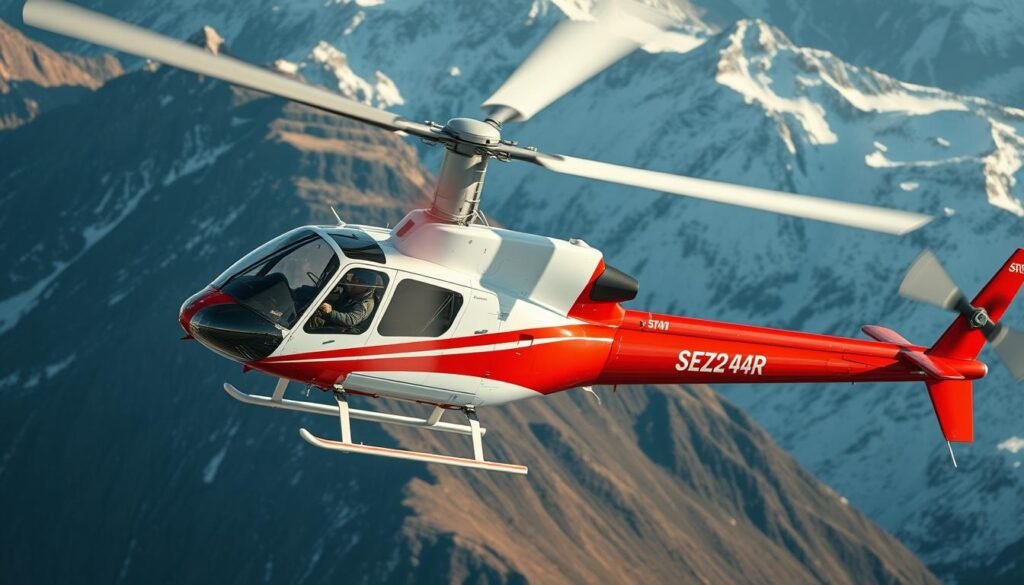Transitioning from fixed-wing to rotary-wing (helicopter) flying can be an exciting yet challenging process. While both types of aircraft share some fundamental aviation principles, flying a helicopter requires learning new skills and techniques due to the unique physics of rotary flight. For fixed-wing pilots looking to expand their horizons, this guide offers tips on how to make a successful transition from airplanes to helicopters.
1. Understand the Differences in Flight Dynamics
The biggest difference between fixed-wing and helicopter flying lies in the flight dynamics. Airplanes rely on forward motion and fixed wings to generate lift, while helicopters achieve lift through the rotation of their rotor blades. This means helicopters can hover, fly backward, and take off vertically—maneuvers that are impossible in fixed-wing aircraft.
Key Differences:
- Lift: In helicopters, the spinning rotor blades generate lift, whereas in airplanes, lift is created by the airflow over fixed wings.
- Control Inputs: Helicopters use the cyclic, collective, and anti-torque pedals for control, while airplanes use yokes/sticks and rudder pedals.
- Hovering: One of the most challenging maneuvers for fixed-wing pilots to master is hovering in place, which requires precise control and constant adjustment.
Tip: Before beginning helicopter flight training, familiarize yourself with the basic principles of rotary flight through reading or simulators to better understand what you’ll encounter.
2. Start with the Right Training Program
Once you’ve decided to transition to helicopter flying, finding a reputable flight school is key. Look for a program that specializes in helicopter training and is FAA-certified under Part 61 or Part 141. Make sure the school has experienced instructors who understand how to teach fixed-wing pilots to adjust to rotary-wing flight.
Choosing the Right School:
- Part 61 vs. Part 141: Part 61 offers a more flexible schedule, while Part 141 is a structured program ideal for full-time students.
- Fleet: Look for schools with well-maintained helicopters, such as the Robinson R22 or R44, which are common training helicopters.
- Instructor Experience: Choose instructors with experience transitioning fixed-wing pilots to helicopters, as they can anticipate your challenges.
Tip: Speak to former fixed-wing pilots who have made the transition to get recommendations on schools and instructors.
3. Master Helicopter Controls: Cyclic, Collective, and Anti-Torque Pedals
Unlike airplanes, helicopters have three primary controls: the cyclic, collective, and anti-torque pedals. Learning how to coordinate these controls simultaneously can be tricky for fixed-wing pilots, who are used to the simpler yoke/stick and throttle system.
Key Controls:
- Cyclic: Controls the helicopter’s direction by tilting the rotor disc in the desired direction. It’s like the yoke or stick in an airplane.
- Collective: Controls the amount of lift by changing the pitch of the rotor blades. It’s similar to the throttle in a fixed-wing aircraft.
- Anti-Torque Pedals: Control the direction the helicopter’s nose is pointing by counteracting the torque produced by the main rotor.
Tip: Spend time in a simulator or with an instructor practicing the coordination between these controls, especially hovering, which requires constant, small adjustments.
4. Develop Your Hovering Skills
Hovering is one of the most difficult maneuvers for fixed-wing pilots to master because it involves controlling the helicopter in a stationary position while managing all three control inputs simultaneously. Unlike an airplane, which stays aloft by moving forward, a helicopter must continuously adjust its rotor pitch and direction to remain stable while hovering.
Key Elements of Hovering:
- Small Adjustments: Constantly make small, precise adjustments with the cyclic, collective, and pedals to keep the helicopter steady.
- Focus on Coordination: You’ll need to develop excellent hand-foot coordination to balance the helicopter during a hover.
Tip: Be patient and expect hovering to be difficult at first. With practice, your control inputs will become more intuitive.
5. Learn to Fly in All Directions: Forward, Backward, Sideways
Unlike fixed-wing aircraft, helicopters can fly in multiple directions: forward, backward, and sideways. This requires fixed-wing pilots to break the habit of thinking in terms of only forward motion and embrace the full versatility of rotary-wing flight.
Directional Control:
- Forward Flight: Similar to airplane flight, but achieved by tilting the rotor disc forward with the cyclic.
- Backward and Sideways Flight: Controlled by tilting the rotor disc in the corresponding direction using the cyclic.
Tip: Practice flying in different directions during your training to fully understand the helicopter’s unique flight capabilities.
6. Adjust to Lower Airspeeds
Helicopters typically fly at lower speeds than airplanes, especially during maneuvers like hovering, landing, and takeoff. As a fixed-wing pilot, you’ll need to adjust to operating in a slower-speed environment. Helicopters usually cruise between 90 and 140 knots, while fixed-wing aircraft typically cruise at much higher speeds.
What to Expect:
- Slower Travel: Helicopters prioritize maneuverability over speed, so flights will take longer compared to fixed-wing travel.
- Approach and Landing: Helicopter approaches are much slower and more controlled, allowing for precision landings in confined spaces.
Tip: Get used to thinking in terms of rotor RPMs and lift rather than speed when flying a helicopter.
7. Get Comfortable with Autorotations
Autorotations are a critical skill for helicopter pilots. In the event of an engine failure, a helicopter can descend safely by using the airflow through the rotor to keep the blades turning, allowing for a controlled landing. This is a major difference from fixed-wing planes, where engine failures are handled through glide paths.
Key Aspects of Autorotation:
- Controlled Descent: During autorotation, the helicopter descends using the momentum of the spinning rotor blades.
- Safe Landings: A successful autorotation allows you to land the helicopter safely without engine power.
Tip: Autorotations require a different mindset than fixed-wing engine-out procedures. Practice regularly to make this maneuver second nature.
8. Understand Rotor and Blade Dynamics
Helicopter pilots need to have a thorough understanding of rotor and blade dynamics to fly safely. Concepts such as blade stall, vortex ring state, and translational lift are unique to helicopters and require specific training.
Key Concepts:
- Blade Stall: Occurs when the rotor blade’s angle of attack becomes too steep, causing a loss of lift.
- Vortex Ring State: A dangerous situation where the helicopter descends into its own downwash, leading to a loss of control.
- Translational Lift: The additional lift gained as the helicopter moves from a hover to forward flight.
Tip: Study these aerodynamic principles closely, as they are crucial to understanding how helicopters behave in different flight regimes.
9. Be Prepared for Increased Workload
Helicopter pilots typically face a higher workload in the cockpit compared to fixed-wing pilots. This is due to the constant adjustments required to maintain stable flight, particularly in hovering or low-speed maneuvers. You’ll need to adjust to the higher physical and mental demands of rotary-wing flight.
Workload Differences:
- Constant Control Input: Unlike airplanes, helicopters require constant adjustments to the controls.
- Situational Awareness: Flying a helicopter demands greater attention to small changes in altitude, speed, and direction, especially during hovering or confined area landings.
Tip: Stay focused and practice until your control inputs become second nature, allowing you to handle the increased workload smoothly.
Conclusion
Transitioning from fixed-wing to helicopter flying can be a rewarding challenge for any pilot looking to broaden their aviation skills. While the transition requires mastering new control systems, flight dynamics, and maneuvers, fixed-wing pilots already have a strong foundation in aviation principles that will help them succeed. By enrolling in a specialized helicopter training program, developing strong hovering skills, and adapting to the unique challenges of rotary-wing flight, fixed-wing pilots can smoothly transition into the exciting world of helicopter aviation.
Related Articles
- Women in Helicopter Aviation: Breaking Barriers and Building a Career
- Freelance Helicopter Pilots: How to Build a Successful Career
- Helicopter Pilot Licensing Requirements: A Global Overview
- How to Network and Advance Your Career as a Helicopter Pilot
- What to Expect in Your First Year as a Commercial Helicopter Pilot
More from This Category
- Work-Life Balance for Helicopter Pilots: Managing a Demanding Career
- How to Transition from Fixed-Wing to Helicopter Flying: Tips for Pilots
- The Best Industries for Helicopter Pilots: Job Opportunities Beyond Passenger Transport
- Medical Requirements for Helicopter Pilots: What You Need to Know
- How to Build Flight Hours as a New Helicopter Pilot
- Essential Skills Every Helicopter Pilot Needs to Succeed
- Top Helicopter Pilot Training Schools: How to Choose the Best Program
- Private vs. Commercial Helicopter Pilot: Which Career Path Is Right for You?
- Helicopter Pilot Salary: What You Can Expect at Every Stage of Your Career
- How to Become a Helicopter Pilot: A Step-by-Step Guide



